The male, or peacock, is predominantly blue with a fan-like crest of spatula-tipped wire-like feathers and is best known for the long train made up of elongated upper-tail covert feathers which bear colourful eyespots. These stiff feathers are raised into a fan and quivered in a display during courtship. Despite the length and size of these covert feathers, peacocks are still capable of flight. Peahens lack the train, and have a greenish lower neck and duller brown plumage. The Indian peafowl lives mainly on the ground in open forest or on land under cultivation where they forage for berries, grains but also prey on snakes, lizards, and small rodents. Their loud calls make them easy to detect, and in forest areas often indicate the presence of a predator such as a tiger. They forage on the ground in small groups and usually try to escape on foot through undergrowth and avoid flying, though they fly into tall trees to roost.
The function of the peacock's elaborate train has been debated for over a century. In the 19th century, Charles Darwin found it a puzzle, hard to explain through ordinary natural selection. His later explanation, sexual selection, is widely but not universally accepted. In the 20th century, Amotz Zahavi argued that the train was a handicap, and that males were honestly signalling their fitness in proportion to the splendour of their trains. Despite extensive study, opinions remain divided on the mechanisms involved.
The bird is celebrated in Hindu and Greek mythology and is the national bird of India. The Indian peafowl is listed as of Least Concern by the International Union for Conservation of Nature (IUCN).
rids
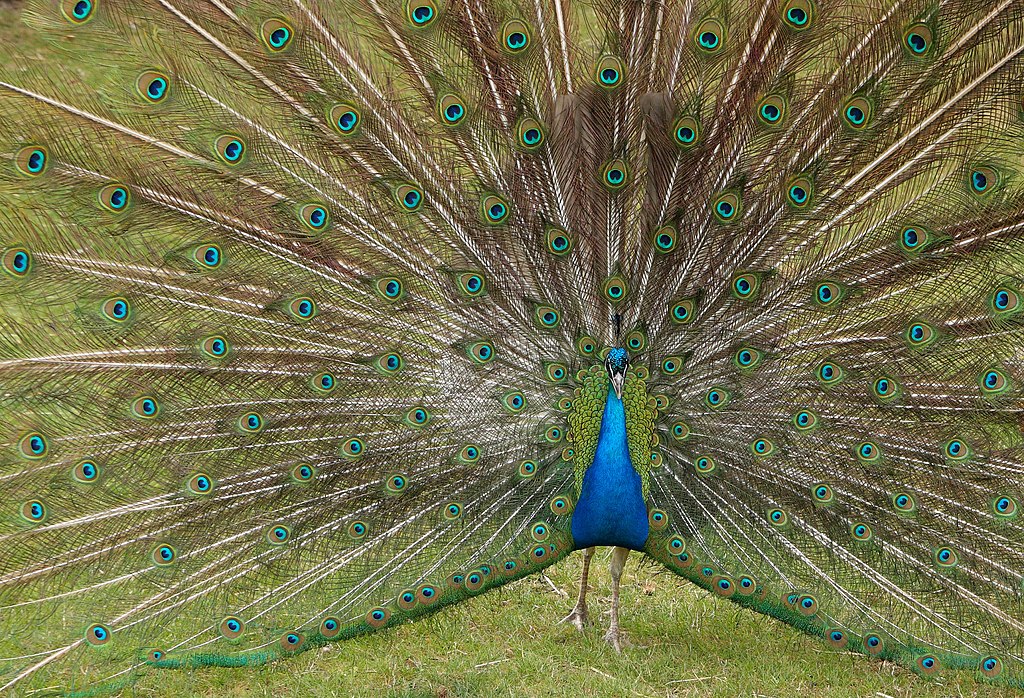
Taxonomy and naming

Female (peahen)
Carl Linnaeus in his work Systema Naturae in 1758 assigned to the Indian peafowl the technical name of Pavo cristatus (means "crested peafowl" in classical Latin).
The earliest usage of the word in written English is from around 1300 and spelling variants include pecok, pekok, pecokk, peacocke, peocock, pyckock, poucock, pocok, pokok, pokokke, and poocok among others. The current spelling was established in the late 17th century. Chaucer (1343–1400) used the word to refer to a proud and ostentatious person in his simile "proud a pekok" in Troilus and Criseyde (Book I, line 210).[2]
The Greek word for peacock was taos and was related to the Persian "tavus" (as in Takht-i-Tâvus for the famed Peacock Throne[3]). The Ancient Hebrew word tuki (plural tukkiyim) has been said to have been derived from the Tamil tokei but sometimes traced to the Egyptian tekh.[4][5] In modern Hebrew the word for peacock is "tavas".
Description
Male neck detail
Call of Pavo cristatus
The most common calls are a loud pia-ow or may-awe. The frequency of calling increases before the Monsoon season and may be delivered in alarm or when disturbed by loud noises. In forests, their calls often indicate the presence of a predators such as the tiger.[6][9] They also make many other calls such as a rapid series of ka-aan..ka-aan or a rapid kok-kok.[9][10] They often emit an explosive low-pitched honk! when agitated.
Mutations and hybrids
A white peafowl that is maintained by selective breeding in many parks such as this one at the Jardin des Plantes, Paris. This leucistic mutation is commonly mistaken for an albino.
Cross between a male green peafowl, Pavo muticus and a female Indian peafowl, P. cristatus, produces a stable hybrid called a "spalding", named after Mrs. Keith Spalding, a bird fancier in California.[15] There can be problems if birds of unknown pedigree are released into the wild, as the viability of such hybrids and their offspring is often reduced (see Haldane's Rule and outbreeding depression).[16][17]
Distribution and habitat
Peacock at Sithulpawwa, Sri Lanka.
Besides its native habitat, the bird has been introduced by humans to the United States, Mexico, Honduras, Colombia, Guyana, Suriname, Brazil, Uruguay, Argentina, South Africa, Portugal, Madagascar, Mauritius, Réunion, Indonesia, Papua New Guinea, Australia, Croatia (Split, island of Lokrum), and elsewhere.[21] In isolated cases, the Indian peafowl has been known to be able to adapt to harsher climates, such as those of northern Canada. The species has been spotted by hunters as far north as Huntsville, Ontario,[citation needed] thriving in its newly adapted northern climate.
Genome sequencing
The first whole-genome sequencing of Indian peafowl identified a total of 15,970 protein-coding sequences, along with 213 tRNAs, 236 snoRNAs, and 540 miRNAs. The peacock genome was found to have less repetitive DNA (8.62%) than that of the chicken genome (9.45%). PSMC analysis suggested that the peacock suffered at least two bottlenecks (around four million years ago and again 450,000 years ago), which resulted in a severe reduction in its effective population size.[22]Behaviour and ecology
Peahen with young
Peafowl forage on the ground in small groups, known as musters, that usually have a cock and 3 to 5 hens. After the breeding season, the flocks tend to be made up only of females and young. They are found in the open early in the mornings and tend to stay in cover during the heat of the day. They are fond of dust-bathing and at dusk, groups walk in single file to a favourite waterhole to drink. When disturbed, they usually escape by running and rarely take to flight.[9]
Peafowl produce loud calls especially in the breeding season. They may call at night when alarmed and neighbouring birds may call in a relay like series. Nearly seven different call variants have been identified in the peacocks apart from six alarm calls that are commonly produced by both sexes.[26]
Peafowl roost in groups during the night on tall trees but may sometimes make use of rocks, buildings or pylons. In the Gir forest, they chose tall trees in steep river banks.[27][28] Birds arrive at dusk and call frequently before taking their position on the roost trees.[29] Due to this habit of congregating at the roost, many population studies are made at these sites. The population structure is not well understood. In a study in northern India (Jodhpur), the number of males was 170–210 for 100 females but a study involving evening counts at the roost site in southern India (Injar) suggested a ratio of 47 males for 100 females.[10]
Sexual selection
Thayer in his "Peacock in the Woods" (1907) suggested that the function of the ornate tail was camouflage
The American artist Abbott Handerson Thayer tried to show, from his own imagination, the value of the eyespots as disruptive camouflage in a 1907 painting.[31] He used the painting in his 1909 book Concealing-Coloration in the Animal Kingdom, denying the possibility of sexual selection and arguing that essentially all forms of animal coloration had evolved as camouflage.[32] He was roundly criticized in a lengthy paper by Theodore Roosevelt, who wrote that Thayer had only managed to paint the peacock's plumage as camouflage by sleight of hand, "with the blue sky showing through the leaves in just sufficient quantity here and there to warrant the author-artists explaining that the wonderful blue hues of the peacock's neck are obliterative because they make it fade into the sky."[33]
In the 1970s a possible resolution to the apparent contradiction between natural selection and sexual selection was proposed. Amotz Zahavi argued that peacocks honestly signalled the handicap of having a large and costly train. However, the mechanism may be less straightforward than it seems – the cost could arise from depression of the immune system by the hormones that enhance feather development.[34][35]
Male courting female
Although the removal of eyespots makes males less successful in mating,[37] eyespot removal substantially changes the appearance of male peafowls. It is likely that females mistake these males for sub-adults, or perceive that the males are physically damaged. Moreover, in a feral peafowl population, there is little variation in the number of eyespots in adult males. It is rare for adult males to lose a significant number of eyespots. Therefore, females' selection might depend on other sexual traits of males' trains. The quality of train is an honest signal of the condition of males; peahens do select males on the basis of their plumage. A recent study on a natural population of Indian peafowls in the Shivalik area of India has proposed a "high maintenance handicap" theory. It states that only the fittest males can afford the time and energy to maintain a long tail. Therefore, the long train is an indicator of good body condition, which results in greater mating success.[38] While train length seems to correlate positively with MHC diversity in males, females do not appear to use train length to choose males.[39] A study in Japan also suggests that peahens do not choose peacocks based on their ornamental plumage, including train length, number of eyespots and train symmetry.[40] Another study in France brings up two possible explanations for the conflicting results that exist. The first explanation is that there might be a genetic variation of the trait of interest under different geographical areas due to a founder effect and/or a genetic drift. The second explanation suggests that "the cost of trait expression may vary with environmental conditions," so that a trait that is indicative of a particular quality may not work in another environment.[37]
Fisher's runaway model proposes positive feedback between female preference for elaborate trains and the elaborate train itself. This model assumes that the male train is a relatively recent evolutionary adaptation. However, a molecular phylogeny study on peacock-pheasants shows the opposite; the most recently evolved species is actually the least ornamented one.[41] This finding suggests a chase-away sexual selection, in which "females evolve resistance to male ploys".[42] A study in Japan goes on to conclude that the "peacocks' train is an obsolete signal for which female preference has already been lost or weakened".[40]
However, some disagreement has arisen in recent years concerning whether or not female peafowl do indeed select males with more ornamented trains. In contrast to Petrie's findings, a seven-year Japanese study of free-ranging peafowl came to the conclusion that female peafowl do not select mates solely on the basis of their trains. Mariko Takahashi found no evidence that peahens expressed any preference for peacocks with more elaborate trains (such as trains having more ocelli), a more symmetrical arrangement, or a greater length.[40] Takahashi determined that the peacock's train was not the universal target of female mate choice, showed little variance across male populations, and, based on physiological data collected from this group of peafowl, do not correlate to male physical conditions. Adeline Loyau and her colleagues responded to Takahashi's study by voicing concern that alternative explanations for these results had been overlooked, and that these might be essential for the understanding of the complexity of mate choice.[43] They concluded that female choice might indeed vary in different ecological conditions.
A 2013 study that tracked the eye movements of peahens responding to male displays found that they looked in the direction of the upper train of feathers only when at long distances and that they looked only at the lower feathers when males displayed close to them. The rattling of the tail and the shaking of the wings helped in keeping the attention of females.[44]
Breeding
Egg, Collection Museum Wiesbaden
The peak season in southern India is April to May, January to March in Sri Lanka and June in northern India. The nest is a shallow scrape in the ground lined with leaves, sticks and other debris. Nests are sometimes placed on buildings[49] and in earlier times have been recorded using the disused nest platforms of the white-rumped vultures. The clutch consists of 4–8 fawn to buff white eggs which are incubated only by the female. The eggs take about 28 days to hatch. The chicks are nidifugous and follow the mother around after hatching.[6] Downy young may sometimes climb on their mothers' back and the female may carry them in flight to a safe tree branch.[50] An unusual instance of a male incubating a clutch of eggs has been reported.[9][51]
Feeding
Peafowl are omnivorous and eat seeds, insects, fruits, small mammals and reptiles. They feed on small snakes but keep their distance from larger ones.[52] In the Gir forest of Gujarat, a large percentage of their food is made up of the fallen berries of Zizyphus.[53] Around cultivated areas, peafowl feed on a wide range of crops such as groundnut, tomato, paddy, chili and even bananas.[10] Around human habitations, they feed on a variety of food scraps and even human excreta.[9] In the countryside, it is particularly partial to crops and garden plants.Mortality factors
Adult peafowl can usually escape ground predators by flying into trees. Large animals such as leopards, dholes and tigers can sometimes ambush them however, and in some areas such as the Gir forest, peafowl are fairly common prey for such formidable predators.[28][54][55] Foraging in groups provides some safety as there are more eyes to look out for predators.[56] They are also sometimes hunted by large birds of prey such as the crested hawk-eagle and rock eagle-owl.[57][58] Chicks are somewhat more prone to predation than adult birds. Adults living near human habitations are sometimes hunted by domestic dogs or by humans in some areas (southern Tamil Nadu) for folk remedies involving the use of "peacock oil".[10]In captivity, birds have been known to live for 23 years but it is estimated that they live for only about 15 years in the wild.[59]
Conservation and status
White Peafowl in Indira Gandhi Zoological Park, Visakhapatnam
Poaching of peacocks for their meat and feathers and accidental poisoning by feeding on pesticide treated seeds are known threats to wild birds.[62] Methods to identify if feathers have been plucked or have been shed naturally have been developed as Indian law allows only the collection of feathers that have been shed.[63]
In parts of India, the birds can be a nuisance to agriculture as they damage crops.[9] Its adverse effects on crops, however, seem to be offset by the beneficial role it plays by consuming prodigious quantities of pests such as grasshoppers. They can also be a problem in gardens and homes where they damage plants, attack their reflections breaking glass and mirrors, perch and scratch cars or leave their droppings. Many cities where they have been introduced and gone feral have peafowl management programmes. These include educating citizens on how to prevent the birds from causing damage while treating the birds humanely.[64][65][66]
In culture
Kartikeya seated on a peacock, painting by Raja Ravi Varma.
In Buddhist philosophy, the peacock represents wisdom.[69] Peacock feathers are used in many rituals and ornamentation. Peacock motifs are widespread in Indian temple architecture, old coinage, textiles and continue to be used in many modern items of art and utility.[20] A folk belief found in many parts of India is that the peacock does not copulate with the peahen but that she is impregnated by other means. The stories vary and include the idea that the peacock looks at its ugly feet and cries whereupon the tears are fed on by the peahen causing it to be orally impregnated while other variants incorporate sperm transfer from beak to beak.[70] Similar ideas have also been ascribed to Indian crow species.[71] In Greek mythology the origin of the peacocks plumage is explained in the tale of Hera and Argus.[15] The main figure of the Yazidi religion Yezidism, Melek Taus, is most commonly depicted as a peacock.[72][73] Peacock motifs are widely used even today such as in the logos of the US NBC and the PTV television networks and the Sri Lankan Airlines.
These birds were often kept in menageries and as ornaments in large gardens and estates. In medieval times, knights in Europe took a "Vow of the Peacock" and decorated their helmets with its plumes. Feathers were buried with Viking warriors[74] and the flesh of the bird was said to cure snake venom and many other maladies. Numerous uses in Ayurveda have been documented. Peafowl were said to keep an area free of snakes.[75] In 1526, the legal issue as to whether peacocks were wild or domestic fowl was thought sufficiently important for Cardinal Wolsey to summon all the English judges to give their opinion, which was that they are domestic fowl.[76]
In Anglo-Indian usage of the 1850s, to peacock meant making visits to ladies and gentlemen in the morning. In the 1890s, the term "peacocking" in Australia referred to the practice of buying up the best pieces of land ("picking the eyes") so as to render the surrounding lands valueless.[77] The English word "peacock" has come to be used to describe a man who is very proud or gives a lot of attention to his clothing.[78]
Pavo cristatus
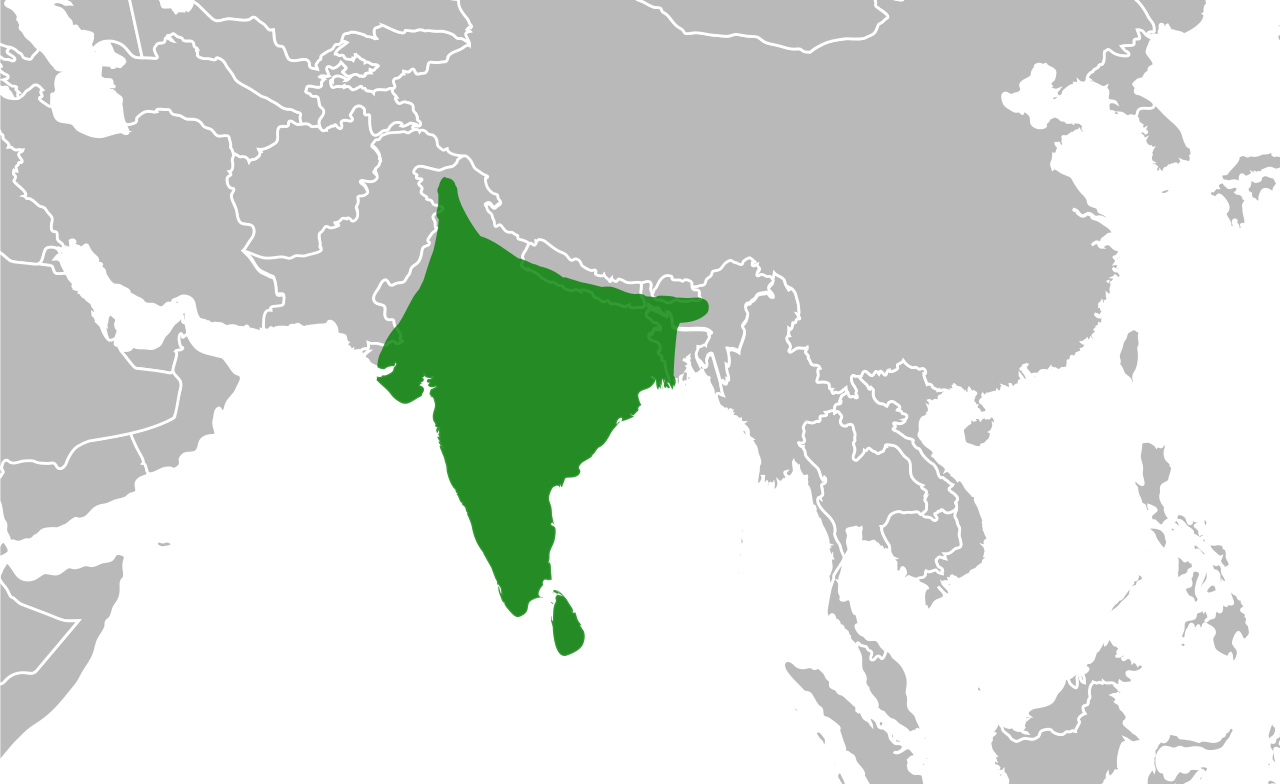
Map showing native range
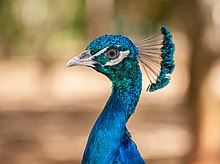


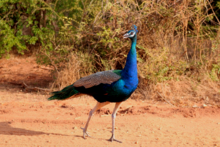

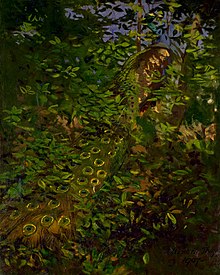
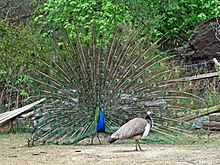




No comments:
Post a Comment
Note: Only a member of this blog may post a comment.